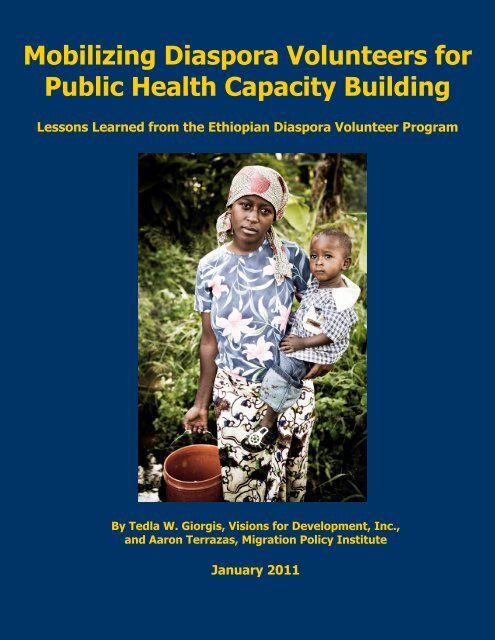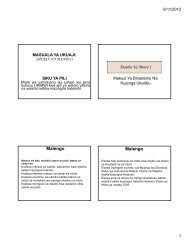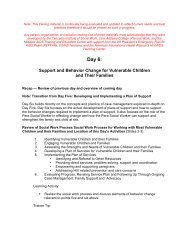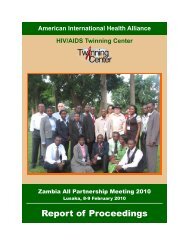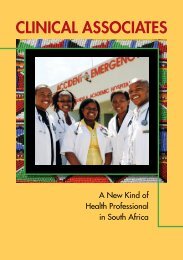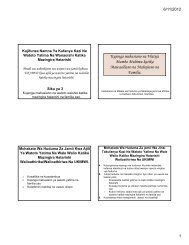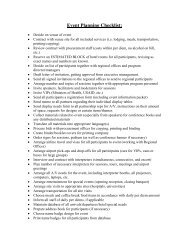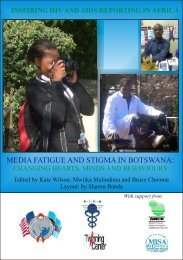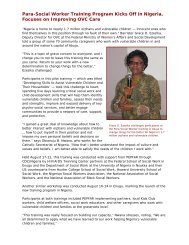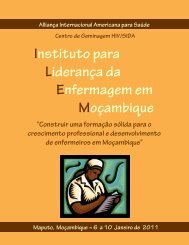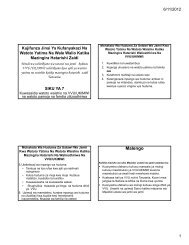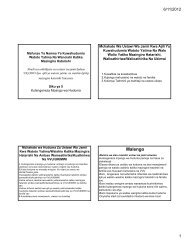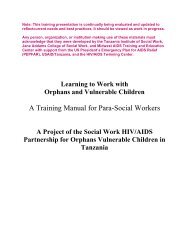Mobilizing Diaspora Volunteers for Public Health Capacity Building
Mobilizing Diaspora Volunteers for Public Health Capacity Building
Mobilizing Diaspora Volunteers for Public Health Capacity Building
Create successful ePaper yourself
Turn your PDF publications into a flip-book with our unique Google optimized e-Paper software.
<strong>Mobilizing</strong> <strong>Diaspora</strong> <strong>Volunteers</strong> <strong>for</strong><br />
<strong>Public</strong> <strong>Health</strong> <strong>Capacity</strong> <strong>Building</strong><br />
Lessons Learned from the Ethiopian <strong>Diaspora</strong> Volunteer Program<br />
By Tedla W. Giorgis, Visions <strong>for</strong> Development, Inc.,<br />
and Aaron Terrazas, Migration Policy Institute<br />
January 2011
Acknowledgments<br />
The Volunteer <strong>Health</strong>care Corps ‐ Ethiopian <strong>Diaspora</strong> Volunteer Program<br />
(EDVP) is a joint project of Visions <strong>for</strong> Development, Inc. and the American<br />
International <strong>Health</strong> Alliance’s (AIHA) HIV/AIDS Twinning Center, a<br />
capacity‐building program that strengthens health systems in support of<br />
the US President’s Emergency Plan <strong>for</strong> AIDS Relief (PEPFAR), the Global<br />
<strong>Health</strong> Initiative, and Millennium Development Goals. The Twinning Center<br />
is funded by PEPFAR through a cooperative agreement from the US<br />
Department of <strong>Health</strong> and Human Services Heath Resources and Services<br />
Administration (HRSA). Twinning Center activities in Ethiopia, including the<br />
EDVP, are supported by CDC/Ethiopia.<br />
This report was in<strong>for</strong>med by the experiences of Tedla W. Giorgis, Executive<br />
Director of Visions <strong>for</strong> Development, Inc. Aaron Terrazas of the Migration<br />
Policy Institute (MPI) provided writing and editing assistance in the context<br />
of MPI’s research on diasporas. The authors thank Aazamina Rangwala of<br />
AIHA and Kathleen Newland of MPI <strong>for</strong> their insight and support of this<br />
project.<br />
© 2011 Visions <strong>for</strong> Development, Inc.<br />
No part of this publication may be reproduced or transmitted in any <strong>for</strong>m<br />
by any means, electronic or mechanical, including photocopy, or any<br />
in<strong>for</strong>mation storage and retrieval system, without permission from Visions<br />
<strong>for</strong> Development, Inc.<br />
Permission <strong>for</strong> reproducing excerpts from this report should be directed to<br />
Tedla W. Giorgis, giorgistw@aol.com.<br />
Suggested citation: Giorgis, Tedla W., and Aaron Terrazas. 2011. <strong>Mobilizing</strong><br />
<strong>Diaspora</strong> <strong>Volunteers</strong> <strong>for</strong> <strong>Public</strong> <strong>Health</strong> <strong>Capacity</strong> <strong>Building</strong>: Lessons Learned<br />
from the Ethiopian <strong>Diaspora</strong> Volunteer Program. Washington, DC: Visions<br />
<strong>for</strong> Development, Inc.
Table of Contents<br />
Executive Summary ………………………………………………………………………………………………….……….. 1<br />
Introduction and Background ……………………………………………………………………………………….…… 2<br />
Origins and Evolution of the Ethiopian <strong>Diaspora</strong> Volunteer Program …….………………………….. 4<br />
Guiding Principles and Lessons Learned ………………………………………………………………….………… 7<br />
Conclusion …………………………………………………………………….………………………………………………….. 11<br />
Appendix ……………………………………………………………….………………………………………………………….. 13<br />
About the Authors …………………………………………………………………….………………………………………. 16
Executive Summary<br />
The human resource challenges facing Sub‐Saharan Africa in the wake of the HIV/AIDS epidemic can<br />
appear daunting, particularly in light of substantial emigration from the continent of educated<br />
healthcare professionals. But there is also a growing recognition that skilled migrants and diasporas<br />
make meaningful contributions to development ef<strong>for</strong>ts in their countries of origin. One avenue is<br />
through volunteer work. Development practitioners have long been aware of the potential of diasporas,<br />
but only recently have they begun to design programs to convert potential into practice.<br />
The Ethiopian <strong>Diaspora</strong> Volunteer Program (EDVP), which is supported by the US President’s Emergency<br />
Plan <strong>for</strong> AIDS Relief (PEPFAR), is a powerful example of how diasporas, donors, and developing countries<br />
work together to build from individual strengths and address common challenges facing the developing<br />
world. EDVP identifies, recruits, and places healthcare volunteers from the Ethiopian diaspora to build<br />
capacity in Ethiopia <strong>for</strong> the treatment of HIV/AIDS. Although small, the program has been successful in<br />
placing committed volunteers and can offer lessons <strong>for</strong> similar ef<strong>for</strong>ts elsewhere in the world.<br />
<strong>Mobilizing</strong> <strong>Diaspora</strong> <strong>Volunteers</strong> <strong>for</strong> <strong>Public</strong> <strong>Health</strong> <strong>Capacity</strong> <strong>Building</strong> | 1
Introduction and Background<br />
There is a growing recognition that diasporas make meaningful contributions to development ef<strong>for</strong>ts in<br />
their countries of origin through donations of their time, talents, and resources. 1 <strong>Diaspora</strong>s frequently<br />
have the contacts, the knowledge, and the personal commitment to undertake these ef<strong>for</strong>ts alone. But<br />
an emerging body of research and experience also documents organized programs that mobilize the<br />
individual ef<strong>for</strong>ts of diasporas, and occasionally, coordinate the ef<strong>for</strong>ts of diasporas with the objectives<br />
of international agencies and developing country governments. In some cases, partnerships among<br />
diasporas, donors, and developing countries can help international aid agencies and developing country<br />
governments meet development objectives while adding value and structure to diasporas’ individual<br />
initiatives.<br />
A powerful example of where diasporas, donors, and developing country governments have<br />
collaborated is the issue of public health capacity building. Among the range of public health challenges<br />
facing developing countries, few are as daunting as the global HIV/AIDS epidemic. According to the<br />
United Nations Program on HIV/AIDS (UNAIDS) and the World <strong>Health</strong> Organization (WHO), 33.4 million<br />
people were infected with HIV as of 2008 of which over two‐thirds (22.4 million) were in Sub‐Saharan<br />
Africa (see Figure 1). 2 Of the estimated 2.7 million people newly infected with HIV/AIDS each year, 97<br />
percent are in developing countries. By contrast, only about 3 percent of the world’s health workers are<br />
in Sub‐Saharan Africa. 3<br />
International donors have responded vigorously to these challenges. In 2003, US President George W.<br />
Bush launched the largest ef<strong>for</strong>t by any nation to combat the global AIDS epidemic. Between 2003 and<br />
2008, the initiative, which came to be known as the President’s Plan <strong>for</strong> AIDS Relief (PEPFAR), supported<br />
medical treatment to more than 2 million people, care to more than 10 million people, and transmission<br />
prevention services to nearly 16 million pregnant mothers. 4 PEPFAR was reauthorized in July 2008 <strong>for</strong><br />
$48 billion over the period 2009 to 2014. <strong>Building</strong> healthcare capacity to treat HIV/AIDS in developing<br />
countries has been a central component of PEPFAR from its start and is essential to ensuring the<br />
sustainability of HIV/AIDS treatment and prevention in developing countries. 5<br />
1 For a review see Kathleen Newland, ed., <strong>Diaspora</strong>s: The New Partners in Global Development Policy (Washington,<br />
DC: US Agency <strong>for</strong> International Development and Migration Policy Institute, 2010).<br />
2 Data in this paragraph are from United Nations Program on HIV/AIDS (UNAIDS) and World <strong>Health</strong> Organization<br />
(WHO), 2009 AIDS Epidemic Update (Geneva: UNAIDS and WHO, November 2009),<br />
http://data.unaids.org/pub/Report/2009/JC1700_Epi_Update_2009_en.pdf.<br />
3 World <strong>Health</strong> Organization, Task Shifting: Rational Redistribution of Tasks among <strong>Health</strong> Work<strong>for</strong>ce Teams,<br />
Global Recommendations and Guidelines (Geneva: World <strong>Health</strong> Organization, the President’s Emergency Plan <strong>for</strong><br />
AIDS, Malaria and Tuberculosis Relief, and the United Nations Program on HIV/AIDS, 2008),<br />
http://www.who.int/healthsystems/TTR‐TaskShifting.pdf.<br />
4 Office of the United States Global AIDS Coordinator, Celebrating Life: The U.S. President’s Emergency Plan <strong>for</strong><br />
AIDS Relief, 2009 Annual Report to Congress (Washington, DC: PEPFAR, 2009),<br />
http://www.pepfar.gov/documents/organization/113827.pdf.<br />
5 Office of the United States Global AIDS Coordinator, The U.S. President’s Emergency Plan <strong>for</strong> AIDS Relief: Five‐<br />
Year Strategy (Washington, DC: PEPFAR, 2009), www.pepfar.gov/strategy/.<br />
<strong>Mobilizing</strong> <strong>Diaspora</strong> <strong>Volunteers</strong> <strong>for</strong> <strong>Public</strong> <strong>Health</strong> <strong>Capacity</strong> <strong>Building</strong> | 2
<strong>Diaspora</strong> volunteers have played a small but important role in ef<strong>for</strong>ts to build healthcare capacity in<br />
developing countries as they strive to address the challenges of the global HIV/AIDS epidemic. 6 The<br />
untapped potential <strong>for</strong> diaspora healthcare volunteers is likely substantial. About 1.4 million medical<br />
professionals in the United States are immigrants – more than one of every six medical professionals in<br />
the country. Of these, about 1.1 million (more than four out of every five) are from developing<br />
countries and over 120,000 (nearly one in 10) are from Sub‐Saharan Africa. 7 These estimates, of course,<br />
exclude immigrants educated as medical professionals but who are either unemployed or work in a<br />
different field. 8<br />
Figure 1. Adults and children estimated to be living with HIV, 2008<br />
Source: UN Program on HIV/AIDS and the World <strong>Health</strong> Organization, 2009.<br />
There is little doubt that this highly educated diaspora represents a substantial asset <strong>for</strong> ef<strong>for</strong>ts to<br />
improve living standards in Sub‐Saharan Africa. However, as noted economist Albert Hirschman<br />
famously observed, a key challenge <strong>for</strong> development practitioners is to mobilize existing resources that<br />
are “hidden, scattered, or badly utilized.” 9 In practice, mobilizing the scattered, latent, or underutilized<br />
6 For a review of how diasporas volunteer in their countries of origin see Aaron Terrazas, Connected through<br />
Service: <strong>Diaspora</strong> <strong>Volunteers</strong> and Global Development (Washington, DC: US Agency <strong>for</strong> International Development<br />
and the Migration Policy Institute, 2010), www.migrationpolicy.org/research/migration_development.php.<br />
7 Migration Policy Institute analysis of data from the US Census Bureau’s 2008 American Community Survey.<br />
Steven Ruggles, J. Trent Alexander, Katie Genadek, Ronald Goeken, Matthew B. Schroeder, and Matthew Sobeck,<br />
Integrated <strong>Public</strong> Use Microdata Series: Version 5.0 [Machine‐readable database] (Minneapolis, Minnesota:<br />
University of Minnesota, 2010). Includes individuals age 25 or older who list their primary occupation as a<br />
pharmacist, physician or surgeon, physician assistant, registered nurse, health diagnosis and treatment<br />
practitioner, diagnostic related technologist or technician, emergency medical technician or paramedic, health<br />
diagnosis and treatment practitioner support technician, licensed practical or vocational nurse, or a nursing,<br />
psychiatric or home health professional.<br />
8 For a discussion of the prevalence of skill underutilization among immigrants see Jeanne Batalova and Michael Fix<br />
with Peter A. Creticos, Uneven Progress: The Employment Pathways of Skilled Immigrants in the United States<br />
(Washington, DC: Migration Policy Institute, 2008), http://www.migrationpolicy.org/pubs/BrainWasteOct08.pdf.<br />
9 Albert O. Hirschman, The Strategy of Economic Development (New Haven, Connecticut: Yale University Press,<br />
1958).<br />
<strong>Mobilizing</strong> <strong>Diaspora</strong> <strong>Volunteers</strong> <strong>for</strong> <strong>Public</strong> <strong>Health</strong> <strong>Capacity</strong> <strong>Building</strong> | 3
skills and expertise of diasporas requires that development policymakers identify thoughtful strategies<br />
and implement targeted programs while retaining a proactive, if also critical, perspective on diasporas’<br />
interests and capacities.<br />
This policy brief reviews the experience of one innovative ef<strong>for</strong>t to mobilize diaspora volunteers to<br />
address healthcare capacity needs in developing countries. It describes the origin, evolution, and lessons<br />
learned from the Volunteer <strong>Health</strong>care Corps (VHC) – Ethiopian <strong>Diaspora</strong> Volunteer Program (EDVP).<br />
The VHC is a component of the PEPFAR‐supported HIV/AIDS Twinning Center, a project of the American<br />
International <strong>Health</strong> Alliance (AIHA), a nonprofit organization that facilitates twinning partnerships<br />
between health‐related institutions in the United States and their counterparts in the developing world.<br />
EDVP is implemented in partnership with the Network of Ethiopian Professionals in the <strong>Diaspora</strong><br />
(NEPID), a nonpartisan network of Ethiopian expatriate professionals managed by the nonprofit group<br />
Visions <strong>for</strong> Development, Inc. The brief does not attempt to comprehensively evaluate the program’s<br />
outcomes, but rather details the program’s operations and draws insights from the perspective of the<br />
program’s coordinator, who is the lead author of this report.<br />
Origins and Evolution of the Ethiopian <strong>Diaspora</strong> Volunteer Program<br />
According to the US Census Bureau’s 2008 American Community Survey (ACS), there were 137,012<br />
Ethiopian immigrants in the United States. In addition, about 30,000 native‐born US citizens claimed<br />
Ethiopian ancestry. 10 The Ethiopian immigrant population in the United States has grown dramatically<br />
over the past three decades from 7,516 in 1980 to 34,805 in 1990 and 69,531 in 2000. Ethiopians are the<br />
second largest immigrant group from Sub‐Saharan Africa in the United States after immigrants from<br />
Nigeria. 11 Compared to other immigrants, Ethiopian‐born immigrants aged 25 and older tend to be<br />
better educated: 59.0 percent had some college education or higher compared to 43.5 percent of all<br />
immigrants. The Ethiopian diaspora extends well beyond the United States and important Ethiopian<br />
diaspora communities reside in Australia, Canada, Germany, the United Kingdom, the Nordic countries,<br />
and Israel, as well as throughout Sub‐Saharan Africa, North Africa, and the Middle East.<br />
In recent years, reaching out to the diaspora and engaging them in Ethiopia’s development has become<br />
an important priority <strong>for</strong> the Ethiopian government. A key challenge has been involving members of the<br />
diaspora who do not wish to return permanently to Ethiopia but who are still enthusiastic about<br />
contributing their time, skills, and energies. Volunteer medical missions by diaspora professionals are a<br />
common mechanism that allows diaspora professionals to contribute to improving living standards in<br />
Ethiopia and helping the country progress toward the Millennium Development Goals. Experience<br />
suggests that these missions are a potentially powerful resource, but they often lack sustainability,<br />
broader impact, and coordination with other similar or related ef<strong>for</strong>ts.<br />
Recognizing the potential of diaspora professionals in helping the Ethiopian government address the<br />
country’s pressing public health challenges, the US government’s Centers <strong>for</strong> Disease Control and<br />
Prevention (CDC), Visions <strong>for</strong> Development, Inc., and other Ethiopian diaspora community‐based<br />
organizations, convened 85 members of the Ethiopian diaspora in Atlanta in July 2005. The participants<br />
10 Unless otherwise indicated, data are from Migration Policy Institute analysis of the 2008 American Community<br />
Survey, and 1980 to 2000 Decennial Censuses.<br />
11 See Aaron Terrazas, “African Immigrants in the United States,” Migration In<strong>for</strong>mation Source, February 2009,<br />
http://www.migrationin<strong>for</strong>mation.org/USFocus/display.cfm?ID=719.<br />
<strong>Mobilizing</strong> <strong>Diaspora</strong> <strong>Volunteers</strong> <strong>for</strong> <strong>Public</strong> <strong>Health</strong> <strong>Capacity</strong> <strong>Building</strong> | 4
aimed to build a consensus <strong>for</strong> the creation of an Ethiopian diaspora network to support Ethiopia’s AIDS<br />
prevention and treatment objectives. They concluded that, among the many obstacles hindering greater<br />
diaspora involvement in addressing Ethiopia’s AIDS challenges, the following were particularly<br />
important:<br />
A lack of in<strong>for</strong>mation in Ethiopia and among international donors concerning the expertise of<br />
overseas Ethiopians and the availability of overseas Ethiopians to undertake volunteer work in<br />
Ethiopia;<br />
Geographic dispersion among the diaspora and a general lack of organizational structures or<br />
systems to match their skills with opportunities to assist in Ethiopia’s HIV/AIDS campaign;<br />
An overreliance on in<strong>for</strong>mal methods of keeping in touch with current needs in Ethiopia,<br />
opportunities to assist, and points of contact;<br />
Discontent among some members of the diaspora concerning prior experience working in<br />
Ethiopia, and a lack of effective feedback and problem‐solving mechanisms in Ethiopia;<br />
Inconsistency of terms and conditions <strong>for</strong> diaspora assignments due to the wide variety and lack<br />
of coordination among the initiatives of independent individuals and organizations.<br />
Between February and May 2006, Visions <strong>for</strong> Development, Inc. conducted an in‐depth one hour<br />
interview to collect qualitative in<strong>for</strong>mation of selected high level health professionals such as physicians,<br />
nurses, epidemiologists, health planners, etc. The qualitative data collected revolved around the<br />
attitudes, perceptions and experiences of Ethiopian diaspora health professionals in the United States<br />
and Canada toward volunteering. The selection of these professionals <strong>for</strong> interview was not random but<br />
the results provide some instructive, although not readily generalized, insights into the pool of potential<br />
Ethiopian diaspora volunteer professionals. 12 Over four‐fifths of the 38 diaspora professionals<br />
interviewed indicated that they were “fairly” or “very” interested in taking up a volunteer assignment in<br />
Ethiopia to address the HIV/AIDS epidemic. Among these, many had extensive experience treating<br />
HIV/AIDS in the United States. Nearly half had visited Ethiopia within the past five years, mostly to visit<br />
family and friends, with a median stay of about one month. Most of the potential volunteers were<br />
motivated by a desire <strong>for</strong> personal satisfaction and <strong>for</strong> recognition of their acquired skills and expertise;<br />
assistance to their country of origin was considered a favorable outcome, but not a key motivation. In<br />
other words, the interest in volunteering was driven less by philanthropy and more by the emotional<br />
and social rewards they expected from volunteering.<br />
However, the interviews also pointed to substantial barriers. While there is a general consensus that<br />
longer or repeat volunteer engagement is more valuable <strong>for</strong> the recipient communities, nearly twothirds<br />
of the people surveyed indicated a preference <strong>for</strong> relatively short volunteer assignments of less<br />
than one month with a minimum of six months advance notice and lead time to prepare <strong>for</strong> the<br />
assignment. When asked more narrowly about their reticence to undertake more protracted volunteer<br />
work, interviewees most often pointed to concerns about job and career responsibilities in the United<br />
States (90 percent) and family responsibilities (50 percent); a lack of awareness of volunteer<br />
opportunities was less commonly cited as a barrier (29 percent). While the prospective participants<br />
acknowledged the need <strong>for</strong> financial and other support services in Ethiopia – as well as transportation –<br />
the lack of compensation was not a major barrier to volunteering. Moreover, the most important<br />
motivations appeared to be national pride, a sense of obligation, and a desire to apply their skills and<br />
expertise.<br />
12 In addition, the fact that the interviewer was a member of the Ethiopian diaspora may have influenced<br />
responses.<br />
<strong>Mobilizing</strong> <strong>Diaspora</strong> <strong>Volunteers</strong> <strong>for</strong> <strong>Public</strong> <strong>Health</strong> <strong>Capacity</strong> <strong>Building</strong> | 5
The interviews also attempted to identify ways to overcome these barriers. The most important factors<br />
cited as contributing to a decision to volunteer were the clear definition of a project that utilizes the<br />
volunteer’s skills and experience, access to resources and support while in Ethiopia, and the provision of<br />
transportation costs to and from Ethiopia.<br />
The Ethiopian <strong>Diaspora</strong> Volunteer Program (EDVP) grew out of these recommendations and the results<br />
of the pilot study. EDVP facilitates the placement of volunteer professionals from the Ethiopian diaspora<br />
in specific sites that lack the human resources necessary to combat HIV/AIDS. The program is structured<br />
as a partnership among several groups that each brings unique talents to the venture.<br />
<br />
<br />
<br />
The American International <strong>Health</strong> Alliance (AIHA) is a nonprofit organization with deep<br />
experience placing volunteer health professionals in developing countries through its HIV/AIDS<br />
Twinning Center program, which is supported by PEPFAR through a cooperative agreement with<br />
the US Department of <strong>Health</strong> and Human Services <strong>Health</strong> Resources and Services Administration<br />
(HRSA). 13<br />
The Network of Ethiopian Professionals in the <strong>Diaspora</strong> (NEPID), the North American <strong>Health</strong><br />
Professionals Association (ENHAPA), People‐to‐People, Inc., and the Ethiopian Infectious Disease<br />
Network (EIDN) are professional associations with extensive contacts in the Ethiopian diaspora<br />
and medical professional communities.<br />
Finally, Visions <strong>for</strong> Development, Inc. is a nonprofit organization that coordinates the project<br />
with AIHA and the various professional and community groups.<br />
The program has two principal objectives. First, to increase the awareness among professionals in the<br />
diaspora of Ethiopia’s National HIV/AIDS campaign and to in<strong>for</strong>m them of opportunities to become<br />
involved in volunteer assignments in Ethiopia. Second, it aims to increase the diaspora’s participation in<br />
Ethiopia’s ef<strong>for</strong>ts to strengthen its health systems and build human resource capacity by placing health<br />
professionals from the diaspora in volunteer positions at government institutions, hospitals and<br />
HIV/AIDS service organizations in Ethiopia.<br />
The Twinning Center office in Ethiopia identifies potential volunteer placement sites, surveys their<br />
specific human resource needs and jointly develops scopes of work <strong>for</strong> each volunteer assignment (see<br />
Figure 1). The partner community‐based organizations and professional networks leverage existing<br />
networks among the diaspora to identify and recruit volunteers. In addition, volunteers are identified<br />
through an online portal and database maintained by NEPID. Visions <strong>for</strong> Development, Inc. vets and<br />
assists in the matching and selection of volunteers; the Twinning Center provides travel‐related logistical<br />
support, orientation, monitoring and on‐going assistance throughout the volunteer mission. AIHA<br />
provides volunteers with a monthly stipend to cover living and housing expenses.<br />
Between September 2006 and December 2010, the program placed 45 volunteers in over 30 placement<br />
sites. Placement sites included Ethiopian Federal Ministry of <strong>Health</strong> (FMoH), regional health bureaus<br />
throughout Ethiopia, local universities (particularly Addis Ababa University), National AIDS Resource<br />
Center, Tikur Anbessa Hospital, John Hopkins University’s Technical Support program <strong>for</strong> PEPFAR’s<br />
Ethiopia HIV/AIDS anti‐retroviral therapy treatment initiative (TSEHAI), and the University of<br />
13 The AIHA Twinning Center manages several programs that place health professionals in Sub‐Saharan Africa. As of<br />
summer 2010, only the Ethiopian program actively recruited diaspora volunteers although preliminary plans <strong>for</strong> a<br />
Nigerian diaspora volunteer program are under review.<br />
<strong>Mobilizing</strong> <strong>Diaspora</strong> <strong>Volunteers</strong> <strong>for</strong> <strong>Public</strong> <strong>Health</strong> <strong>Capacity</strong> <strong>Building</strong> | 6
Washington’s International Training and Education Center <strong>for</strong> <strong>Health</strong> (I‐TECH). These volunteers<br />
contributed a total of 552 months of volunteer time with an average volunteer assignment of around 12<br />
months. 14 Several profiles of individual volunteers are included in the appendix to this report, but they<br />
per<strong>for</strong>med a wide range of functions including developing pain treatment guidelines <strong>for</strong> the country’s<br />
health professionals, building an online plat<strong>for</strong>m <strong>for</strong> the FMoH, per<strong>for</strong>ming outreach to <strong>for</strong>eign<br />
universities, refining and developing medical curricula <strong>for</strong> the country’s teaching hospitals, and<br />
examining the country’s anti‐retroviral treatment program.<br />
Figure 1. Volunteer Recruitment and Placement<br />
Source: Visions <strong>for</strong> Development, Inc.<br />
Guiding Principles and Lessons Learned<br />
The experience of the EDVP is an example of how the energies and expertise of diaspora volunteers can<br />
be mobilized through the ef<strong>for</strong>ts of government and nonprofit institutions in the origin and destination<br />
countries. Doubtlessly, the experience is also of value to other ef<strong>for</strong>ts to mobilize diaspora volunteers.<br />
This section identifies key lessons learned from the program. Below we list several guiding principles and<br />
14 Visions staff identifies potential candidates through its network of Ethiopian professionals and interviews them<br />
using a structured interview questionnaire. Interviews are conducted at the convenience of the interviewee,<br />
mostly in person or over the telephone.<br />
<strong>Mobilizing</strong> <strong>Diaspora</strong> <strong>Volunteers</strong> <strong>for</strong> <strong>Public</strong> <strong>Health</strong> <strong>Capacity</strong> <strong>Building</strong> | 7
lessons learned that, we believe, have led to the relative success of EDVP. They are drawn from<br />
questionnaire data collected from returned volunteers, site assessments and evaluations, exit debriefs<br />
with individual volunteers, and focus group conversations with volunteers, as well as insights from the<br />
program coordinators. Many are similar to good practices identified <strong>for</strong> other volunteer programs; some<br />
are also unique to diaspora volunteer programs. 15<br />
1. <strong>Volunteers</strong> have diverse motives <strong>for</strong> undertaking a mission abroad.<br />
Research points to at least seven motivational factors that predict volunteerism: the opportunity to<br />
express values, desire to improve understanding, to create or expand social networks, to advance career<br />
opportunities, to improve understanding, to enhance ego and emotional wellbeing, or to support and<br />
assist a specific community. 16 In addition, personal factors and life circumstances have also proven to be<br />
highly relevant. For the individual volunteer, the literature suggests that ensuring a meaningful<br />
volunteer mission is central: volunteers must feel that they have developed substantive intrapersonal<br />
relationships and provided valuable services. In the case of diaspora volunteers, all of these factors – in<br />
addition to commitment to and ongoing personal engagements in the country of origin, and frequently,<br />
a desire to “pay back” – contribute to a high propensity and willingness to engage in volunteer work in<br />
their countries of origin. However, many volunteers also consider their engagement as a significant<br />
sacrifice requiring protracted absence from work and family life.<br />
<strong>Volunteers</strong> who participated in the EDVP are a diverse group and have different needs, motivations, and<br />
expectations. Of the 38 Ethiopian diaspora professionals interviewed in the EDVP pilot study, a desire to<br />
help address HIV/AIDS in Ethiopia, a feeling of responsibility to give back to Ethiopia, and pride in<br />
Ethiopian heritage were the most common motivations <strong>for</strong> interest in volunteering while monetary<br />
compensation and academic credit were less common. Indeed, <strong>for</strong> many of the prospective volunteers,<br />
the HIV/AIDS epidemic in Ethiopia was a familiar reality: four of every five knew or previously knew<br />
someone who was living with or had been affected by HIV/AIDS in Ethiopia. On balance, the experience<br />
of EDVP suggests that volunteers from the Ethiopian diaspora – presumably similar to other diaspora<br />
volunteers – principally seek a meaningful personal experience rather than pecuniary rewards.<br />
2. Individualized attention to the motivations of diaspora volunteers throughout the volunteer<br />
mission from recruitment through return leads to the selection of dedicated volunteers.<br />
15 For a review of lessons and good practices from other volunteer programs, see Jill Keesbury, The Value of<br />
International Volunteerism: A Review of Literature on International Volunteer‐Sending Programs (Washington, DC:<br />
USAID Development In<strong>for</strong>mation Service, July 2003) and Elon Gilbert, Robert Navin, Gary Alex, Eric Benschoter,<br />
Anne Cullen and Ronni Flannery, Managing International Volunteer Programs: A Farmer‐to‐Farmer Manual<br />
(Washington, DC: USAID, March 2005).<br />
16 See the various writings of psychologists Mark Snyder and Allen Omoto including “Volunteerism: Social issues,<br />
perspectives, and social policy implications,” Social Issues and Policy Review, vol. 2 (2008): 1‐36; “<strong>Volunteers</strong> and<br />
volunteer organizations: Theoretical perspectives and practical concerns,” in Improving leadership in nonprofit<br />
organizations, edited by R. E. Riggio and S. S. Orr (San Francisco: Jossey‐Bass, 2004); “Considerations of<br />
Community: The Context and Process of Volunteerism,” American Behavioral Scientists, no. 45 (2002): 846‐867;<br />
and “Basic research and practical problems: Volunteerism and the psychology of individual and collective action,”<br />
in The practice of social influence in multiple cultures, edited by W. Wosinska, R. Cialdini, D. Barrett and J.<br />
Reykowski (Mahwah, NJ: Erlbaum, 2001) among others.<br />
<strong>Mobilizing</strong> <strong>Diaspora</strong> <strong>Volunteers</strong> <strong>for</strong> <strong>Public</strong> <strong>Health</strong> <strong>Capacity</strong> <strong>Building</strong> | 8
To address the individual needs and motivations of volunteers, and to ensure that the volunteer mission<br />
produced a meaningful experience, EDVP customizes work plans and volunteer missions – <strong>for</strong> instance,<br />
by designing volunteer opportunities specifically <strong>for</strong> academics on sabbatical, recent graduates, workers<br />
transitioning between jobs, and migrants exploring the idea of permanent repatriation to their country<br />
of origin. This individualized attention, the program’s coordinators believe, has led to an extraordinarily<br />
high retention rate: No volunteer has abandoned an ongoing mission, a rare feat <strong>for</strong> most volunteer<br />
programs in the developing world.<br />
However, customization requires that the program invest substantial energies in interviewing and<br />
vetting prospective volunteers, as well as in identifying potential placement sites and developing<br />
detailed work plans <strong>for</strong> volunteers. Follow‐up with the volunteers throughout their mission and <strong>for</strong><br />
three to six months after their return is also required. This follow‐up with volunteers – what the<br />
program’s coordinator call “case management” – is considered a critical feature of the program. It<br />
allows program coordinators to address challenges or issues as they arise rather than allowing problems<br />
to fester leading to a negative experience <strong>for</strong> the volunteer (which should be avoided since returned<br />
volunteers are the most prominent ambassadors <strong>for</strong> the program). However, many volunteers also<br />
consider their engagement as a significant sacrifice requiring protracted absence from work and family<br />
life.<br />
3. Volunteer missions must meet the needs of both individual volunteers and the host sites to<br />
ensure sustainable impact.<br />
Program coordinators – AIHA and Visions in this case – must carefully balance the individual needs and<br />
motivations of volunteers with the human resource needs of host sites. The objective of the volunteer<br />
program is to build self‐sustaining HIV/AIDS treatment capacity within Ethiopian health institutions. In<br />
this regard, the EDVP is designed as a tripartite partnership between the volunteers, the coordinators,<br />
and the host sites. The role of the coordinator is critical: not only as a placement service, but also to<br />
ensure that volunteers and hosts maximize the impact of the volunteer mission.<br />
In the case of the EDVP, interviews were a critical mechanism to understand the motivations and level of<br />
commitment of prospective volunteers and, the authors suspect, had enormous consequences <strong>for</strong> the<br />
success of volunteer missions. Indeed, to date, no volunteer has dropped out or prematurely left the<br />
program. Detailed interviews allowed the program coordinators to screen applicants and to manage<br />
volunteers’ expectations.<br />
Equally, if not more important, has been the close collaboration and buy‐in from Ethiopian government<br />
officials. By placing diaspora volunteers in policy development rather than just service delivery positions<br />
– <strong>for</strong> example, as an advisor to the Ethiopian <strong>Health</strong> Minister – the program is able to influence local<br />
decision‐makers and is more likely to have a lasting impact.<br />
4. The most effective recruitment and management strategies <strong>for</strong> diaspora volunteers rely on<br />
deeply rooted personal relationships within diaspora communities.<br />
The experience of EDVP suggests that the most effective way to recruit and manage diaspora volunteers<br />
is through partnerships with individuals and organizations that maintain deep personal ties in diaspora<br />
communities. These individuals are typically familiar with the particular challenges and issues <strong>for</strong> each<br />
diaspora community and their participation promotes ownership by the diasporas. In some instances,<br />
<strong>Mobilizing</strong> <strong>Diaspora</strong> <strong>Volunteers</strong> <strong>for</strong> <strong>Public</strong> <strong>Health</strong> <strong>Capacity</strong> <strong>Building</strong> | 9
embassies or consulates can also serve a similar function as intermediaries although where the diaspora<br />
is politicized or where a diaspora has little confidence in the country of origin government, partnership<br />
with diplomats can be counterproductive.<br />
In the case of the EDVP, interviews were a critical mechanism to understand the motivations and level of<br />
commitment of prospective volunteers and, the authors suspect, had enormous consequences <strong>for</strong> the<br />
success of volunteer missions. Indeed, to date, no volunteer has dropped out or prematurely left the<br />
program. Detailed interviews allowed the program coordinators to screen applicants and to manage<br />
volunteers’ expectations.<br />
5. Even diaspora volunteers require orientation and careful attention to managing<br />
expectations can lead to more positive volunteer missions.<br />
It has often been argued that diaspora volunteers do not require cultural orientation since they are<br />
typically familiar with their countries of origin. The experience of EDVP suggests otherwise. <strong>Diaspora</strong><br />
volunteers return to a country that has often changed substantially from the country they left, and the<br />
volunteers themselves have also often changed during their tenure abroad. Local workers view<br />
diasporas ambivalently, sometimes recognizing their achievements while being skeptical of their<br />
expertise at other times. Indeed, diasporas often assume the workplace culture of the societies where<br />
they reside rather than the societies where they originate. If diaspora volunteers are cautious and<br />
diplomatic, their capacity to intermediate between the two cultures can catalyze a gradual cultural shift.<br />
Otherwise, they lack the outsider credibility of a non‐diaspora volunteer. These risks are best addressed<br />
during an orientation process.<br />
Similarly, diaspora volunteers often harbor outsized expectations regarding the impact or conditions of<br />
the volunteer mission, particularly accommodation, the level of supervision and transportation. Many<br />
have spent extended periods of time away from the country of origin or are unfamiliar with working<br />
conditions in the developing world. There is typically a narrow window of opportunity during which a<br />
professional can volunteer and programs face the constant risk of losing that energy or enthusiasm and<br />
generating cynicism. Un<strong>for</strong>tunately, there is no simple solution to this conundrum beyond managing the<br />
expectations of outgoing volunteers and ensuring that diaspora volunteers understand how their<br />
individual mission fits into a broader development strategy or diaspora engagement framework. This<br />
requires some degree of policy coordination and political buy‐in. In the case of the EDVP, the initiative<br />
currently benefits from the support of Ethiopia’s <strong>Health</strong> Minister and the United States’ continued<br />
commitment to HIV/AIDS prevention and treatment in the developing world.<br />
EDVP has addressed these challenges by providing <strong>for</strong>ums <strong>for</strong> diaspora volunteers to interact with each<br />
other and with experienced volunteers. For instance, the transition back to Ethiopia can be draining or<br />
isolating <strong>for</strong> some of the volunteers. Opportunities to share their experiences with other volunteers can<br />
help alleviate these personal stresses and deliberate ef<strong>for</strong>ts must be taken to create and sustain<br />
networks that allow volunteers to collaborate and provide peer‐to‐peer support. These ef<strong>for</strong>ts can range<br />
from email list serves, to periodic meetings, to connecting current volunteers with returned volunteer<br />
mentors. Small ef<strong>for</strong>ts – such as providing volunteers with official identification – can have a substantial<br />
impact on volunteers’ experience.<br />
6. Continuing to engage the volunteer after a mission ends is essential.<br />
<strong>Mobilizing</strong> <strong>Diaspora</strong> <strong>Volunteers</strong> <strong>for</strong> <strong>Public</strong> <strong>Health</strong> <strong>Capacity</strong> <strong>Building</strong> | 10
There is clear value in retaining contact with volunteers <strong>for</strong> subsequent longer‐term placements. Once<br />
an assignment has finished and the diaspora volunteer returns to his or her country of residence, the<br />
benefits of the placement may diminish. Careful ef<strong>for</strong>ts must be made to build local capacity and build<br />
lasting connections between the volunteer and the placement site to ensure sustainability. Encouraging<br />
return volunteers, subsequent volunteer missions, and virtual relationships are all viable options to this<br />
end.<br />
Box 1. In their own words<br />
Advice from volunteers<br />
<br />
<br />
<br />
<br />
<br />
“Prepare yourself to tolerate a variety of things, problems, and people. Don’t compare the<br />
system to the United States or any other country. There are many layers to any situation<br />
and issue, and a lot of grey areas taking time to adjust.”<br />
“Make absolutely sure your placement institute is willing and able to facilitate the Scope<br />
of Work.”<br />
“Be patient with the bureaucracy. The culture is different so remember to be culturally<br />
appropriate. Being an Ethiopian in the diaspora is different than being a diaspora living in<br />
Ethiopia, so be prepared to be treated as such.”<br />
“Interact with all people and don’t be arrogant. Embrace other opinions.”<br />
“Be open and reactive and try to establish a good rapport with staff who have a lot of<br />
experience to share. You must be a self-starter and do not expect a lot of direction. Have<br />
a positive approach and people will be positive too. You can’t change everything<br />
overnight but you can bring about positive change and new energy.”<br />
Advice from volunteer hosts<br />
<br />
<br />
<br />
“Since placement sites have limited resources <strong>for</strong> supervision, the volunteers should be<br />
independent, highly motivated, and self-starters who do not require close monitoring and<br />
supervision.”<br />
“The scope of work should reflect that volunteers need to concentrate in capacity building<br />
rather than simply doing project work; deliverables should be written as such.”<br />
“While privy to the scope of work and signed agreements between the Twinning Center<br />
and the volunteer, many placement site supervisors wanted to be familiar with the signed<br />
agreement (i.e., vacation, leave of absence provisions, travel, benefits, etc.).”<br />
Conclusion<br />
The Ethiopian <strong>Diaspora</strong> Volunteer Program is a powerful example of where diasporas, international<br />
donors, and developing countries have collaborated to address global development challenges and meet<br />
common needs and the program has been highlighted by US policymakers as an example of the<br />
country’s commitment to the developing world. For instance, on AIDS Day 2006, President George W.<br />
Bush invited a <strong>for</strong>mer EDVP volunteer to participate in a White House discussion on volunteering. EDVP<br />
is not the first program to mobilize diaspora volunteers to address development challenges. The United<br />
<strong>Mobilizing</strong> <strong>Diaspora</strong> <strong>Volunteers</strong> <strong>for</strong> <strong>Public</strong> <strong>Health</strong> <strong>Capacity</strong> <strong>Building</strong> | 11
Nations Development Program, the International Organization <strong>for</strong> Migration, the UK’s Department <strong>for</strong><br />
International Development, Voluntary Service Overseas and Canadian University Service Overseas have<br />
all managed volunteer programs targeted specifically to diaspora professionals.<br />
The experience of the Ethiopian <strong>Diaspora</strong> Volunteer Program confirms the lessons of many of these<br />
earlier programs. For instance, in noting that the recruitment, placement, and management of<br />
volunteers requires considerable administration, that long‐term engagement yields greater returns, and<br />
that reasonable stipends are necessary to attract qualified volunteers but the emotional and personal<br />
benefits of volunteering likely outweigh any possible monetary compensation. It also faces many of the<br />
same challenges of these earlier diaspora volunteer programs including scale and sustainability. As with<br />
all diaspora volunteer programs, coordinating the activities of donors, developing countries, diaspora<br />
groups, and volunteers requires deft administration.<br />
In spite of these challenges, the potential of diaspora volunteers to help international and national<br />
development agencies meet the Millennium Development Goals is undeniable. Substantial volunteer<br />
activity is already underway via in<strong>for</strong>mal links and person‐to‐person contacts. Greater coordination and<br />
cooperation among the various actors would likely improve impacts and outcomes. Similar to other<br />
volunteer ef<strong>for</strong>ts – diaspora volunteers are an important, if discreet, tool among many others in the<br />
development policy arsenal.<br />
<strong>Mobilizing</strong> <strong>Diaspora</strong> <strong>Volunteers</strong> <strong>for</strong> <strong>Public</strong> <strong>Health</strong> <strong>Capacity</strong> <strong>Building</strong> | 12
Appendix<br />
<strong>Volunteers</strong> who participate in the Ethiopian <strong>Diaspora</strong> Volunteer Program have per<strong>for</strong>med a wide range<br />
of functions. The examples below highlight seven specific cases.<br />
Volunteer A.<br />
Objective: To assist a major US university to build the capacity of the national palliative care initiative in<br />
Ethiopia.<br />
Term: April 2007 to April 2010.<br />
Major Accomplishments:<br />
Initiated the establishment of the Palliative Care (PC) Resource & Documentation Unit.<br />
Contributed to the creation of a Palliative Care Resource Database.<br />
Initiated contact/networked with key national and international stakeholders on the issues of<br />
palliative care and HIV/AIDS.<br />
Contributed to the national pain management consultancy team in developing a national opioid<br />
policy.<br />
Volunteer B.<br />
Objective: To improve health and nutrition services <strong>for</strong> vulnerable sections of the Ethiopian population<br />
by advising the Federal Ministry of <strong>Health</strong>’s National Nutrition Program.<br />
Term: February 2010 to February 2011<br />
Major accomplishments:<br />
Served as the main nutrition contact person at the Federal Ministry of <strong>Health</strong> (FMoH); mobilized<br />
resources, monitored implementation of programs, supported FMoH staff, attended all nutrition<br />
related meetings.<br />
Organized and led a need assessment study to examine the industrial and regulatory<br />
environment <strong>for</strong> food <strong>for</strong>tification in Ethiopia.<br />
Initiated and participated in the review of the existing HIV‐Nutrition Guidelines <strong>for</strong> Ethiopia. This<br />
also included updating training manuals <strong>for</strong> health professionals working with anti‐retroviral<br />
therapy.<br />
Highly engaged in development of a module <strong>for</strong> training/up‐grading <strong>Health</strong> Extension<br />
Practitioners in Ethiopia.<br />
Volunteer C.<br />
Objective: Assist the FMoH in improving their online presence and in developing an In<strong>for</strong>mation and<br />
Documentation Center to allow greater access to in<strong>for</strong>mation.<br />
Term: December 2008 to December 2010<br />
<strong>Mobilizing</strong> <strong>Diaspora</strong> <strong>Volunteers</strong> <strong>for</strong> <strong>Public</strong> <strong>Health</strong> <strong>Capacity</strong> <strong>Building</strong> | 13
Major accomplishments:<br />
Developed a website, training guide and website user manual, as well as trained FMoH staff on<br />
content management.<br />
Was a committee member <strong>for</strong> major activities of FMoH such as the Safe Motherhood Campaign<br />
and Acute Watery Diarrhea (AWD), and assisted in developing a communication strategy and<br />
materials.<br />
In collaboration with ARC, designed a brochure, pocket size calendar, bookmark, banners, bags<br />
and t‐shirts <strong>for</strong> the International AIDS Conference in Vienna.<br />
Prepared and presented a website design <strong>for</strong> the International Conference on HIV/AIDS and STIs<br />
conference to be held in 2011.<br />
Volunteer D.<br />
Objective: To strengthen and establish academic outreach programs with <strong>for</strong>eign universities and other<br />
funding organizations.<br />
Term: September 2009 to March 2011<br />
Major accomplishments (to date):<br />
Implemented a project on improving maternal health in collaboration with Emory University and<br />
the Gates Foundation.<br />
Coordinated medical missions to Tikur Anbessa Hospital in Addis Ababa with American and<br />
Canadian medical teams as well as other short‐ and long‐term visits by visiting <strong>for</strong>eigners at<br />
Addis Ababa University School of Medicine.<br />
Wrote grant proposals, memorandums of understanding, and progress reports <strong>for</strong> many of<br />
Addis Ababa University School of Medicine’s international partners.<br />
Volunteer E.<br />
Objective: To build human resource capacity at Tikur Anbessa Hospital to provide physical therapy to<br />
people living with HIV/AIDS.<br />
Term: February 2010 to February 2011<br />
Major accomplishments (to date):<br />
Developed doctoral curriculum and identified faculty <strong>for</strong> physical therapy studies at Tikur<br />
Anbessa Hospital and Addis Ababa University School of Medicine.<br />
Collaborated with an international non‐governmental organization to organize a two‐day<br />
seminar on physical therapy to about 25 physicians in the town of Dire Dawa in eastern Ethiopia.<br />
Instructed a two‐day course on specialized treatment of shoulder injuries <strong>for</strong> physical therapists<br />
in the Addis Ababa region.<br />
Provided face‐to‐face consultations with patients at Tikur Anbessa Hospital.<br />
Restructured inpatient and outpatient facilities in the Physical Therapy Department of Tikur<br />
Anbessa Hospital to enhance efficiency of service delivery.<br />
Advocated the establishment of a permanent focus on physical therapy at the FMoH to identify<br />
national standards.<br />
<strong>Mobilizing</strong> <strong>Diaspora</strong> <strong>Volunteers</strong> <strong>for</strong> <strong>Public</strong> <strong>Health</strong> <strong>Capacity</strong> <strong>Building</strong> | 14
Volunteer F.<br />
Objective: To assist the communications and public relations ef<strong>for</strong>ts of the Federal Ministry of <strong>Health</strong>.<br />
Term: August 2008 to July 2011<br />
Major accomplishments (to date):<br />
Collaborated on various communications strategies; coordinated high level visits and organized<br />
events.<br />
Worked with web developers from a major American university to redesign the Ministry’s<br />
website.<br />
Developed research proposals<br />
Volunteer G.<br />
Objective: To provide technical assistance <strong>for</strong> the implementation of tuberculosis and HIV treatment<br />
programs in federal and regional health bureaus and to build capacity of federal staff in research,<br />
epidemiology, and data analysis.<br />
Term: August 2008 to August 2011<br />
Major accomplishments (to date):<br />
Provided epidemiological expertise, reviewed guidelines, participated in training of health<br />
workers, and conducted research and evaluation.<br />
Conducted retrospective study of the anti‐retroviral treatment program in 16 private hospitals<br />
in and around Addis Ababa.<br />
Prepared protocol to improve tuberculosis detection in rural areas.<br />
Advised medical students at local universities.<br />
Developed databases <strong>for</strong> administrative and evaluation data at regional health bureaus.<br />
Developed a monitoring and evaluation plan <strong>for</strong> the national maternal, newborn and child<br />
health communications and advocacy strategy aimed at reducing maternal and neonatal deaths.<br />
Organized research seminar <strong>for</strong> local medical researchers.<br />
<strong>Mobilizing</strong> <strong>Diaspora</strong> <strong>Volunteers</strong> <strong>for</strong> <strong>Public</strong> <strong>Health</strong> <strong>Capacity</strong> <strong>Building</strong> | 15
About the Authors<br />
Tedla W. Giorgis is Founder and Executive Director of Visions <strong>for</strong> Development, Inc. A clinical<br />
psychologist with over 30 years of experience in the United States and Ethiopia, Dr. Giorgis has<br />
previously worked and consulted <strong>for</strong> the District of Columbia Department of Mental <strong>Health</strong>, the World<br />
Bank, the United Nations Children’s Fund (UNICEF), the African American Institute, and the Center <strong>for</strong><br />
Development and Population Activities among other national and international organizations. He has<br />
been awarded the Eli Lilly Primary Care Award (2002) and the Gwendolyn Cafritz Foundation Award<br />
(2005) and has been extensively published in academic journals. Dr. Giorgis is the author of<br />
Understanding Depression, Alcohol and Drugs: Personal Guide <strong>for</strong> Ethiopians and Multicultural<br />
Competence: A Case Study in Mental <strong>Health</strong> Service Delivery.<br />
Aaron Terrazas is a Policy Analyst at the Migration Policy Institute (MPI), a non‐partisan think tank<br />
based in Washington, D.C. dedicated to the study of international migration and its policy consequences<br />
<strong>for</strong> communities at origin and destination. Mr. Terrazas has published over a dozen studies on the<br />
impacts of the recent economic crisis <strong>for</strong> migration flows and migrants in the labor market, diasporas as<br />
agents of development in their countries of origin, and immigrant integration. His recent studies include<br />
Migration and Immigrants Two Years after the Financial Collapse: Where Do We Stand? (co‐author) and<br />
Connected through Service: <strong>Diaspora</strong> <strong>Volunteers</strong> and Global Development.<br />
<strong>Mobilizing</strong> <strong>Diaspora</strong> <strong>Volunteers</strong> <strong>for</strong> <strong>Public</strong> <strong>Health</strong> <strong>Capacity</strong> <strong>Building</strong> | 16
American International <strong>Health</strong> Alliance<br />
HIV/AIDS Twinning Center<br />
1250 Eye Street NW, Suite 350<br />
Washington, DC 20005<br />
www.aiha.com<br />
www.twinningagainstaids.com/volunteers<br />
Network of Ethiopian<br />
Professionals in the <strong>Diaspora</strong><br />
P.O. Box 73145<br />
Washington, DC 20056<br />
www.nepid.org


